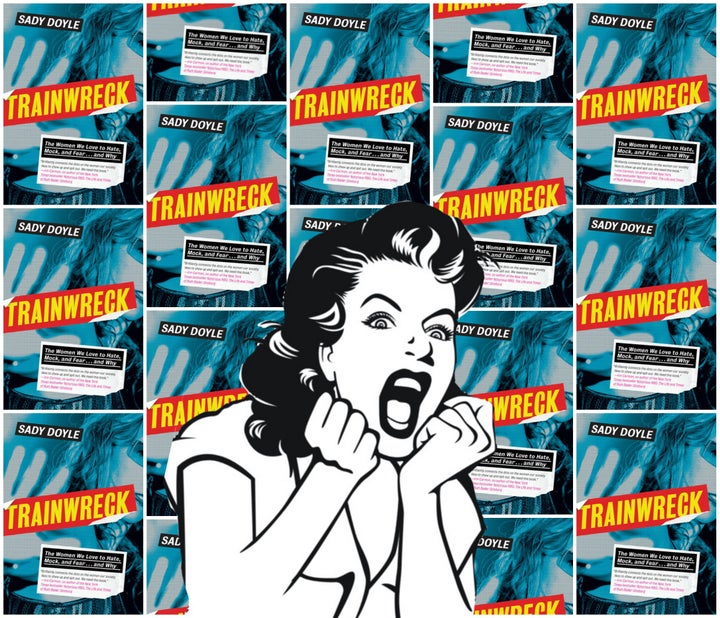
A couple years ago, we hated Anne Hathaway.
Remember that? Maybe you (specifically) still do. Maybe you (specifically) never did. But it’s true. We hated her big, effortful smile. We hated how she tremulously murmured “it came true” when accepting an Academy Award for Best Supporting Actress. We hated her molars and uvula, visible thanks to some close camera work as she belted “I Dreamed a Dream” in “Les Misérables,” the film for which she won that Oscar. We hated how she let us see her trying. We hated how she reminded us of our own need to be liked and our own carefully disguised efforts to impress.
Jennifer Lawrence, the starlet who tripped over her gown at the Academy Awards and professed her love for junk food ― she was genuine, America’s effortlessly perfect dream bestie. Until she wasn’t.
This cycle might feel painfully familiar: We anoint an It Girl, a beloved female icon, then rapidly begin to find things to despise about her. Soon she’s left torn and trampled in the dirt as we rush past her to the next victim.
In Sady Doyle’s sharp new book Trainwreck: The Women We Love to Hate, Mock, and Fear… and Why, she examines the particular pleasure our society has taken, for centuries, in tearing down publicly visible women. Early feminist Mary Wollstonecraft, French revolutionary Anne-Josèphe Théroigne de Méricourt, and Harriet Jacobs, author of Incidents in the Life of a Slave Girl, all suffered the same calculated public humiliations and dismissals that were later faced in different forms by Sylvia Plath, Billie Holiday, Britney Spears and Whitney Houston.
“It’s easy to look at these women and see what they did wrong, tally up their sins and errors,” writes Doyle in the preface of Trainwreck: “Insensitive, provocative, promiscuous, off-the-wagon, crazy.” Many of them were deeply, seriously flawed people; all of them were flawed, of course, because humans are. By highlighting the same destructive pattern, though, Doyle reveals how quick our society is to discard flawed women ― baby, bathwater and all ― then blame them for forcing us to get rid of the baby because they tainted the bathwater.
She details the arc of classic ‘90s trainwreck Monica Lewinsky, a counterpoint to the equally loathed Hillary Clinton (“The icy blonde and the overheated brunette, the prude and the slut, the shrewish wife and the trashy mistress, the sexless middle-aged woman and the trampy young one, the frigid, man-hating intellectual and the needy, man-hungry ditz”) and notes that ultimately, to American society, “neither woman was acceptable. Neither woman was deemed worthy of love, or even of being liked.”
Then came Britney Spears, the perfect Madonna/whore middle ground, whom Doyle casts as a reaction to the Clinton/Lewinsky villainesses. “To save herself from the hatred that defined the public lives of Hillary Clinton and Monica Lewinsky, the ideal woman would have to steer between them, like Scylla and Charybdis,” she argues, “navigating the currents without being swept toward either side: Virgin and pin-up, wide-eyed innocent and worldly temptress, icon of cool and conservative Christian role model, she would always have to be both and neither, everything and nothing.” And yet Britney, too, suffered a much-derided public downfall.
Our trainwrecks, Trainwreck shows us, are constantly generated as reactions to our era’s anxieties and bigotries, or as backlashes to what we thought we wanted before. We ask women to fulfill the roles we require, then despise them for spoon-feeding us, or for not spoon-feeding us well enough ― that’s how we arrived at Kristin Stewart (who didn’t try hard enough or smile hard enough), then Anne Hathaway (who tried too hard and smiled too hard), then Jennifer Lawrence (who did both too ... just right). And, of course, that’s how we arrived at hating them.
“We ask women to fulfill the roles we require, then despise them for spoon-feeding us, or for not spoon-feeding us well enough.”
Doyle’s book doesn’t arrive out of thin, misogynistic air; she’s one of many feminist writers and agitators who’ve been calling out this dynamic in essays and on Twitter for years. Though past stars’ falls from grace (Britney, Lindsay Lohan) have been covered with wide-eyed surprise, outlets like Jezebel forecasted a backlash against Jennifer Lawrence during her reign of unrivaled popularity. So did Lawrence herself, who said in an interview, “I feel like I’m becoming way too much [...] They like me now, but I’m going to get really annoying really fast. Just watch.”
In recent years, the growing number of feminist-oriented women’s news sites have picked up on the reality that female celebrities face harsher scrutiny, and more intense hatred, spurred on by these hints from the stars themselves. Hathaway, who makes her living as a Hollywood actress, rather heartbreakingly told HuffPost in 2014, “My impression is that people needed a break from me.”
As with other feminist issues, the past few years has seen a surge of awareness in the media, and a reckoning of sorts. Doyle notes that celebrities like Spears and Miley Cyrus have tried to harness the power of their notoriety, to varying degrees of success. Others, like Lawrence and Hathaway, have gently critiqued the viciously fickle nature of audiences. Writers have penned think pieces that, though less likely to be mocked, were preceded by Chris Crocker’s viral video “Leave Britney Alone” (to which Doyle gives due attention in Trainwreck). The media and audiences have grown more aware that our tendency to tear public women to shreds is unfair, sexist, damaging to gender equality.
Still, women in public aren’t yet equal. And if you were suffering under that delusion, Trainwreck is particularly illuminating, a reminder that the moment when a problem, in its most obvious form, has become taboo might actually be the most dangerous moment. In fact, it’s a perfect opportunity for that problem to hide in a more sneaky form. If we’re all being more careful not to hate on women for smiling, for suffering from a mental illness or for being sexually active while in the public eye, chances are we’ll find other reasons to disproportionately target women for over-the-top takedowns: bitchiness, insensitivity, offensiveness, and other crimes that might ruin a woman’s reputation more effectively than assault allegations could ruin a man’s.
Doyle writes that “[t]he trainwreck is the inverse of what a woman ought to be.” In a time when “Are you a feminist?” is a de rigeur interview question for starlets, there’s another set of criteria for what a woman ought to be ― not replacing the old one, certainly, but in addition. Women today are asked to maintain their sexiness, receptiveness, agreeableness and caring natures, as detailed in Trainwreck, but also be strong, independent, and politically aware. When Rihanna got back together with Chris Brown after he’d badly beaten her, Doyle points out, she had neither the support of the Brown stans (who’d always blamed her for their hero’s downfall) nor of the purportedly pro-woman crowd who berated her for setting a bad example. “[I]t was always Rihanna’s responsibility not to be abused,” she writes, “and, no matter what she did, she was always blamed for any abuse that did or could happen.”
We always have female targets who are considered correct to hate out of all proportion; it’s only the rationales that change. If we passionately despise Taylor Swift, it’s not because she strikes us as too girly and too obsessed with her brand and her ex-boyfriends ― it’s because it’s offensive that she lied about whether she approved Kanye West’s line about her on the track “Famous.” If we loathe Lena Dunham, it’s not for her neuroses, size, or penchant for talking about her own experiences and insecurities ― it’s because she allegedly molested her sister (she did not) and is racially insensitive at best (this is not wrong). If we react callously to Kim Kardashian being reportedly bound, gagged, and robbed at gunpoint, it’s just because she totally faked it for attention or an insurance payout (we assume). Never mind the open glee with which many greeted the downfall or suffering of these celebrities, the joy at having an acceptable reason to trash them, often with very gendered language ― the critiques were certainly valid, but the vitriol spoke to something else.
“Women in public aren’t yet equal. And if you were suffering under that delusion, 'Trainwreck' is particularly illuminating.”
Hillary Clinton and even Florida congresswoman Debbie Wasserman Schultz, imperfect politicians both, have been excellent targets for our collective misogynistic bile. Wasserman Schultz, who resigned in disgrace as head of the DNC after emails were leaked that suggested the organization had favored Clinton over the outsider Bernie Sanders, faced a hysterical backlash rooted in a long-time dislike amongst much of the party. While she’d doubtless drawn ire for certain political actions (see: her medical marijuana position, her support for the payday loan industry) and DNC choices (such as the odd primary debate schedule, believed to have favored the more well-known candidate), the feverish pitch was remarkable. She was booed offstage at the convention; critics have called her “Frizzilla,” “despised,” “an irritant” and slammed her as obsessed with her personal advancement. The last one might be particularly important. It grates on us that a woman might prioritize her own ambition. As Clinton herself has noted, her favorability ratings have dipped to shocking lows when she’s run for president, but when she’s been quietly, unobtrusively serving ― say, as Secretary of State ― we just love her.
We hate these women, often, all the more because they aligned themselves with feminism and then proved flawed. Through the Trainwreck lens, it’s obvious why there’s no mercy for female error. In an early chapter, Doyle traces how groundbreaking feminist Mary Wollstonecraft, who had a highly unconventional and dramatic romantic history, was reduced to a crazy, unstable slut after her death ― a narrative that overshadowed her work so completely that the feminist movement itself screeched, temporarily, to a halt. “As Wollstonecraft went,” Doyle writes, “so went her cause.” And because her shaming had harmed the women’s rights movement, women resented her flaws the most: “[I]t was women, in fact, who increasingly drove the shaming of Wollstonecraft, in an effort to avoid being associated with her disgrace,” she argues. “The only way for a woman to engage in feminism at all, it turned out, was to actively participate in the shaming.”
Women, as Doyle states at the end of her book, have never had so much opportunity to speak out, and yet this doesn’t mean the book on trainwrecks has been closed. Simply being spoken of in public as a woman was once considered deeply shameful, but to this day, women who ask for our attention, our vote, our money ― women who have the gall to exist unabashedly in public ― make us unsettled. “Women who have succeeded too well at becoming visible have always been penalized vigilantly and forcefully, and turned into spectacles,” she writes in the preface ― and that hasn’t changed.
“We hate these women, often, all the more because they aligned themselves with feminism and then proved flawed.”
Perhaps the closest women can come to living in public without being torn apart by the public is to guard their private lives so carefully that their mistakes can’t slip out ― an approach that, as Doyle shows with Spears, can catastrophically collapse. For now, Beyoncé exists mostly, to her fans, as an unobtainable artistic icon, not a woman who sits for interviews and goes clubbing. We have nothing to critique but her carefully crafted art, which no one can revile for being slutty, needy, try-hard, calculating or pathetic ― it’s her art. Elena Ferrante, the author of the smash-hit Neapolitan novels, hid her identity entirely, writing under a pseudonym to avoid her personal life becoming the public’s focus instead of her writing. We love them for not seeming to want anything from us, our attention or our affection. They’re just giving us their art and staying out of our way.
We’re vigilant, of course, for that illusion to shatter. It inevitably does, and both women have been under siege; Beyoncé has had her moments of mass critique and Elena Ferrante’s identity was recently revealed by a New York Review of Books report. When it does finally shatter, Trainwreck suggests, there’s rarely any warmth left for our once beloved women stars.

